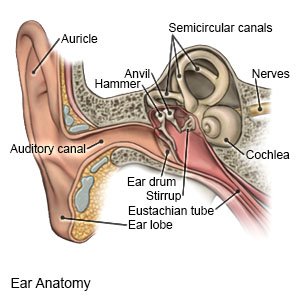Mastoiditis
Medically reviewed by Drugs.com. Last updated on Jun 30, 2025.
What is mastoiditis?
Mastoiditis is an infection in the mastoid bone of your skull. The mastoid bone is located behind your ear. Mastoiditis is often caused by an ear infection that spreads. Your risk for mastoiditis may increase if you have a chronic condition that weakens your immune system. Your ear canal swells and traps fluid inside your ear. Trapped fluid causes bacteria to grow and spread to your mastoid bone.
 |
What are the signs and symptoms of mastoiditis?
- Pain, redness, swelling, or tenderness behind or inside your ear
- Thick drainage from your ear
- Headache
- Fever
- Fatigue or feeling irritable
- Vomiting or loss of appetite
- Hearing loss
How is mastoiditis diagnosed?
Your healthcare provider will examine your ear, and ask about your signs and symptoms. Your provider may feel the outside of your ear for pain or swelling. Your provider may check your hearing. You may also need any of the following:
- Blood tests may show infection or give information about your overall health.
- A fluid culture is a test of the fluid that drains from your ear. Fluid cultures may show the kind of bacteria causing the infection. Your healthcare provider may have to insert a small needle with a tube into your ear to get a fluid sample.
- X-ray, CT, or MRI pictures may show swelling and infection of the mastoid bone. The pictures may also show if there is bone damage or an abscess in your skull or brain. You may be given contrast liquid to help your skull, brain, and ear structures show up better in the pictures. Tell the healthcare provider if you have ever had an allergic reaction to contrast liquid. Do not enter the MRI room with anything metal. Metal can cause serious injury. Tell the healthcare provider if you have any metal in or on your body.
How is mastoiditis treated?
You may need to spend a few days in the hospital for treatment and monitoring. You may be cared for by a healthcare provider with training in ear, nose, and throat conditions. You may also need any of the following:
- Medicine may be given to treat an infection or decrease pain and fever. Medicine may be given as an IV, eardrops, or pills.
- Ear drainage may be done to remove fluid from your ear. Your healthcare provider will insert a small needle with a tube attached to it. Your provider will remove fluid through the tube. This may relieve pressure and pain.
- Surgery may be needed if other treatments do not work. Surgery may include placing a tube in your ear to help drain pus and fluid. It may also include removing part of the infected mastoid bone.
What can I do to care for my ears?
Keep your ears dry. Do not allow water or liquids to get into your ears. Use earplugs as directed when you shower or swim.
Have someone call your local emergency number (911 in the US) if:
- You have a seizure or lose consciousness.
- You cannot be woken.
When should I seek immediate care?
- Your symptoms, such as pain, redness, swelling, ear drainage, or hearing loss get worse.
- Your fever gets worse, or does not go away with treatment.
- You have a headache that does not go away with treatment.
- You have weakness in your face.
- You have a headache, fever, and a stiff neck.
When should I call my doctor?
- You think your medicine is not working.
- You have questions or concerns about your condition or care.
Care Agreement
You have the right to help plan your care. Learn about your health condition and how it may be treated. Discuss treatment options with your healthcare providers to decide what care you want to receive. You always have the right to refuse treatment. The above information is an educational aid only. It is not intended as medical advice for individual conditions or treatments. Talk to your doctor, nurse or pharmacist before following any medical regimen to see if it is safe and effective for you.© Copyright Merative 2025 Information is for End User's use only and may not be sold, redistributed or otherwise used for commercial purposes.
Learn more about Mastoiditis
Treatment options
Care guides
Further information
Always consult your healthcare provider to ensure the information displayed on this page applies to your personal circumstances.
